TEAMAero - SWBLI
The Project
Shock-Wave/Boundary Layer-Interaction (SBLI) is a phenomenon of strong industrial and scientific interest because of the strong, and negative, impact it has in many aeronautical applications and the somehow obscure physics of the problem. SBLI is studied in the context of the European project TEAMAero (Towards Effective Flow Control and Mitigation of Shock Effects In Aeronautical Applications). Within this framework, 15 Early Stage Researchers (ESRs) from 7 universities, 3 research centres, and 2 companies focus on investigating SWBLI together with the support of their supervisors and several industrial partners. Within the project, experimental and numerical studies will be carried on with the aim of gaining a better physical understanding of the problem in the context of turbomachinery and channels for internal aerodynamics and wings for external flows. The project also aims at developing cutting-edge tools for flow characterization through the introduction of new, improved experimental techniques and numerical models. Here at the University of Glasgow, the main attention is devoted to the development and calibration of numerical models for the study of external flows around three-dimensional wings.
PANS for Buffet Flows
The SBLI occurring over the supercritical airfoil OAT15A was studied experimentally by Jacquin et al. [1] in 2009 at ONERA and represents one of the most detailed experiments in the literature. This test case is investigated by means of Partially averaged Navier-Stokes (PANS) simulations [2]. During the first part of the project, the capability of PANS to adequately reproduce the self-sustained shock oscillation (buffet) occurring on the suction side of the airfoil is assessed. PANS seems promising for its ability to improve the results of URANS even for affordable mesh sizes. Fig. 1 shows the buffet flow for a PANS simulation at AoA = 3.5°, Re = 3e+06, and M = 0.73.
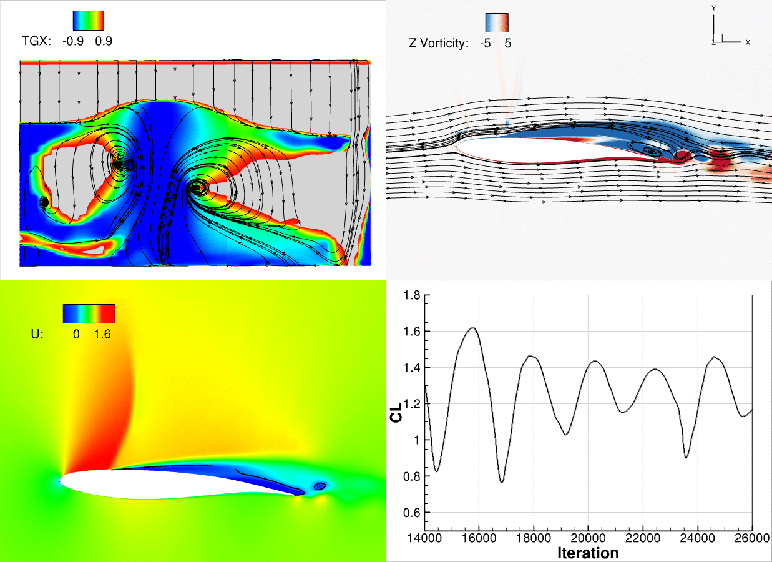
Fig. 1: Shock motion and lift coefficient for the OAT15A airfoil at buffet condition.
The PANS approach showed its applicability as an enhanced, less dissipative version of URANS (fig. 1), that allowed unlocking the flow instability for the case under analysis at no additional cost. On the other hand, if a fine grid is employed, this strategy can be used to perform scale-resolving simulations to focus on the flow physics. Fig. 2 shows a visualization of the Q-Criterion isosurface around a circular cylinder at Re = 50000. The resolution is governed by the parameter fk.
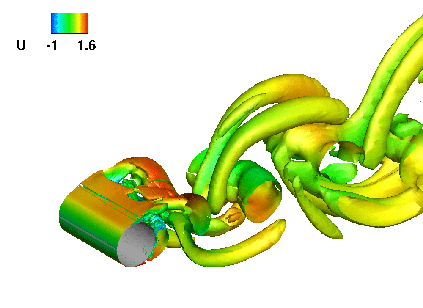
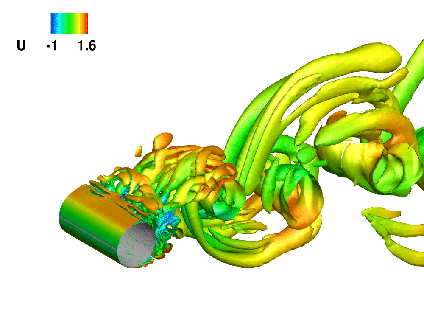
Fig. 2: Q Criterion (Q=0.1) iso-surface around a circular cylinder ar Re=50000. Left: fk = 0.6; right: fk = 0.2;
The following steps concern the application of the PANS method to three-dimensional configurations, internal SBLI (e.g. pseudo-shock in rectangular channels), and the testing of PANS in conjunction with non-linear correction and four-equation models.
A short project presentation (video) can be found on:
Buffet Onset with RANS-based Criteria
Because of the low frequency of the shock oscillation driving the buffet, a URANS approach may seem the most appropriate to represent the phenomenon. Still, there is no consensus on the capability of URANS to predict the buffet, being this technique influenced by factors like turbulence modelling, numerical schemes, spatiotemporal discretisation and the influence of the wind tunnel geometry. Therefore, scale-resolving simulations have become popular in this context. Unfortunately, the associated CPU costs are high.
An accurate and affordable method is required to predict the onset of buffet for a wide of flight conditions. RANS-based criteria were proposed in recent years and only focus on integral or local steady quantities (fig. 3 for an explanation). Even in this case, many steady computations must be carried out. Here, these criteria have been re-proposed in conjunction with an adjoint method to accelerate the buffet boundary tracking.



Fig. 3: RANS-based criteria for the buffet onset estimate using the lift (left) and momentum (centre) coefficients, and the trailing edge pressure coefficient (right).
The formulated algorithm allows for recovering the criteria results in their standard forms. At the same time, a saving of 50-60% of the CPU time. The algorithm was tested for the OAT15A and NACA0012 aerofoils, for which data on the experimental onset is available. The adopted criteria maintain a conservative nature, since tend to underestimate the onset angle of attack, and are therefore applicable in the industrial design phase.
More details at: https://doi.org/10.1016/j.ast.2022.107664
Buffet Onset using Harmonic Balance Method
The use of buffet criteria is limited to steady computations and their accuracy strongly depends on the employed turbulence model. It is believed that time marching simulations can improve the prediction of the buffet onset, in spite of the large CPU cost associated with them. When dealing with periodic flows, the use of the frequency domain reduces the CPU costs needed for the several periods of oscillations and the transient needed to reach periodic conditions. Among the pool of available methods, the harmonic balance method [3] has been widely used to study turbomachinery and rotor flows, where the frequency of the periodic flow is known a priori. Self-induced, unsteady flows, like vortex shedding or transonic buffet flows, introduce a problem related to the lack of knowledge of the fundamental flow frequency. The gradient-based variable time period (GBVTP) method of McMullen et al. [4] can evaluate the buffet frequency starting from a guess value.
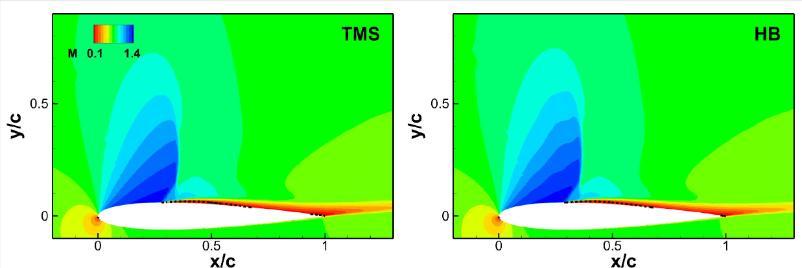
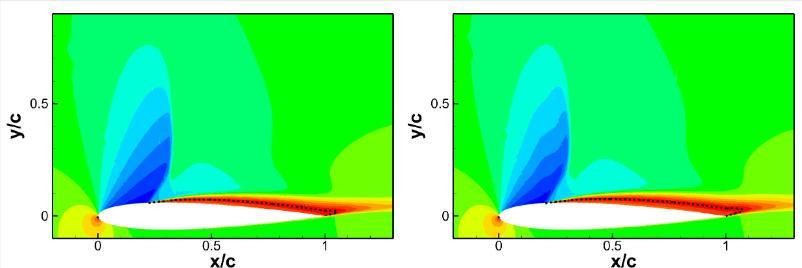
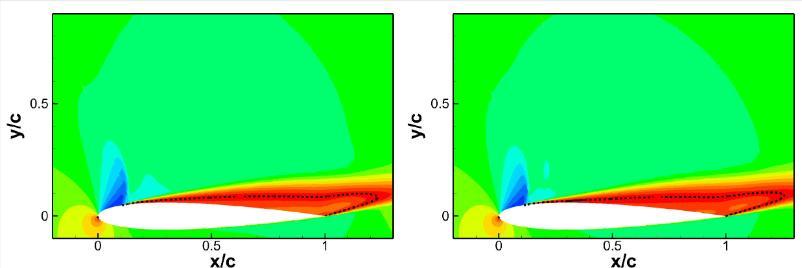
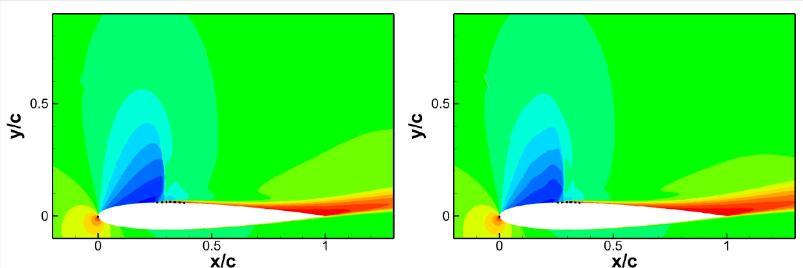
Fig. 4: Mach number contours for the flow around the NACA0012 aerofoil computed with TMS (left) and HB (right) at different phases in a buffet period (Rec=6 ×106, M=0.72 and α=6.00deg). From top to bottom: most downstream position, upstream moving shock, most upstream position, downstream moving shock. The dashed, black lines represent the zero-longitudinal velocity isolines.
The method proved able to recover the results of the time marching simulations. Moreover, if a sufficient number of harmonics is used, the harmonic balance computations adequately describe all phases of buffet (see fig. 4). The harmonic balance computations were then embodied in a simple procedure for the buffet boundary estimation for two 2D configurations. The results confirmed the noticeable decrease in the CPU cost associated with the buffet boundary characterisation with respect to time-marching simulations. Compared to a past work, where RANS-based criteria were adopted, the prediction of the buffet boundary was improved for flight conditions where the turbulence model adequately predicts the buffet onset.
More details at: https://doi.org/10.1016/j.ast.2022.108086.
A brief introduction to this and the previous section are given in this short video: https://www.youtube.com/watch?v=I-nSyGfrdrk
Scientific Training SC2
The University of Glasgow held the second Scientific Training (SC2) Recent Developments in Computational Fluid Dynamics in the context of TEAMAero. The course covered several CFD methods like Finite Volume Method, Lattice Boltzmann Method, Vortex Methods, Smooth Particle Hydrodynamics and Kinetic Flow Modelling. Theoretical lectures were alternated with practical sessions focused on the implementation of the aforementioned mathematical models. In a joint effort with NUMECA, an industrial partner of TEAMAero, a seminar on the industrial application of CFD for rotary wings and turbomachinery was also given.
TEAMAero Social Media Pages
- LinkedIn: https://www.linkedin.com/showcase/h2020-teamaero/
- Twitter: https://twitter.com/h2020_teamaero
Social Media Contents:
- Project Overview: LinkedIn, Twitter
- 2D Flow Visualisation: LinkedIn
- Buffet Boundary Estimation Techniques: YouTube
References
[1] L. Jacquin, P. Molton, S. Deck, B. Maury, and D. Soulevant. Experimental Study of Shock Oscillation over a Transonic Supercritical Profile. AIAA Journal, 47:1985– 1994, 2009.
[2] S.S. Girimaji and K.S. Abdol-Hamid. Partially-averaged Navier Stokes Model for Turbulence: Implementation and Validation. In AIAA Aerospace Sciences Meeting and Exhibit, Reno, NE, USA, 2005.
[3] K. Hall, J. Thomas, W. Clark, Computation of unsteady nonlinear flows in cascades using a harmonic balance technique, AIAA J. 40 (2002) 879–886.
[4] M. McMullen, A. Jameson, J. Alonso, Demonstration of nonlinear frequency domain methods, AIAA J. 44 (2006) 1428–1435.
Publications
- A. Petrocchi and G.N. Barakos, Buffet boundary prediction using RANS-based criteria and adjoint methods, Aerospace Science and Technology, Vol. 126, 2022. https://doi.org/10.1016/j.ast.2022.107664.
- A. Petrocchi, G. N. Barakos, Buffet boundary estimation using a harmonic balance method, Aerospace Science and Technology, Vol. 132, 2023, 108086, https://doi.org/10.1016/j.ast.2022.108086.
- A. Petrocchi, G. N. Barakos, "Transonic Buffet Simulation Using A Partially-Averaged Navier-Stokes Approach". In: 8th European Congress on Computational Methods in Applied Sciences and Engineering (ECCOMAS 2022), Oslo, Norway, 5-9 June 2022.
https://doi.org/10.23967/eccomas.2022.278. - A. Petrocchi, G. N. Barakos, "Transonic Buffet Simulation using Harmonic Balance Method". In: AIAA SciTech 2023 Forum, 23-27 January 2023, National Harbor, MD, US & Online. https://doi.org/10.2514/6.2023-2276.
CONTACTS
George N. Barakos, Professor - George.Barakos@glasgow.ac.uk
Rene Steijl, Senior Lecturer - Rene.Steijl@glasgow.ac.uk
Andrea Petrocchi, PhD Student (PGR) - a.petrocchi.1@research.gla.ac.uk


